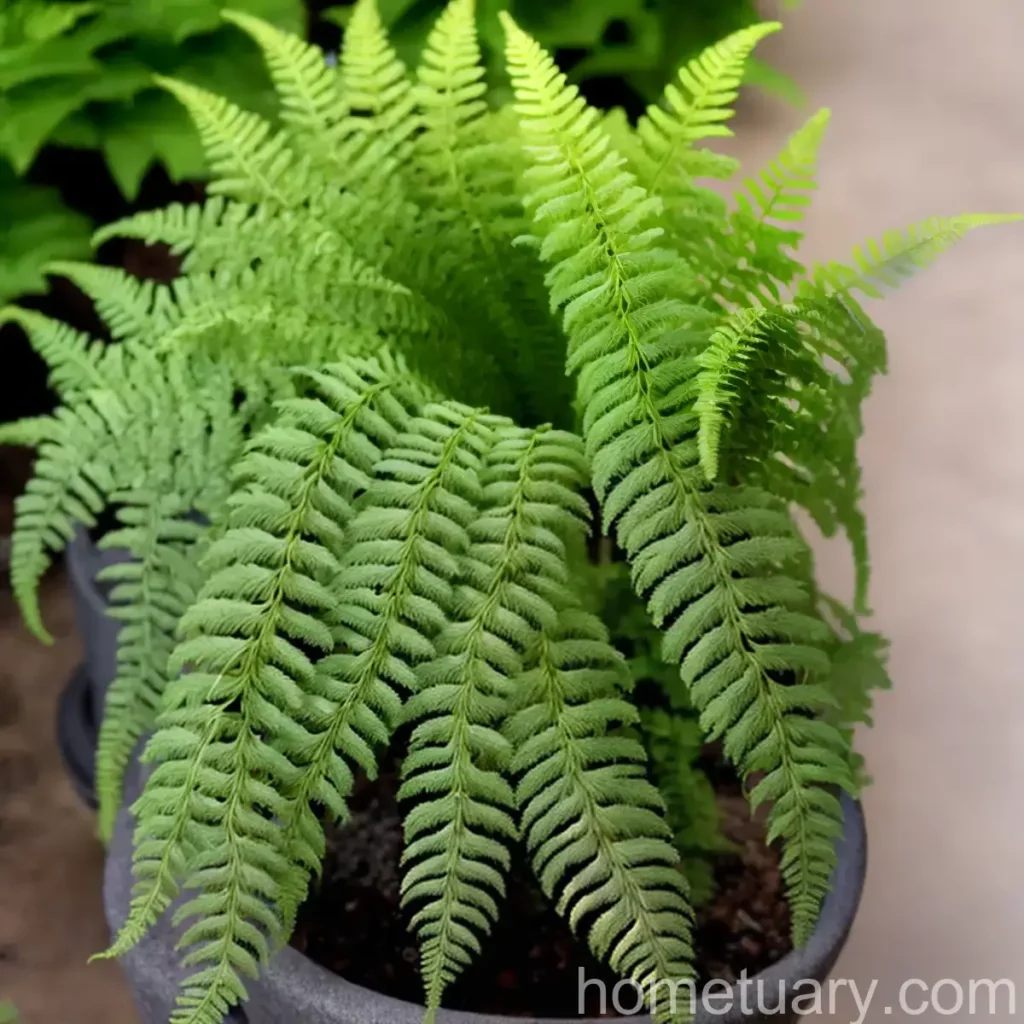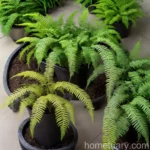Eared Lady Fern (Athyrium otophorum) – A Comprehensive Guide
Plants have the ability to enhance our environment and bring a sense of tranquility to any space they inhabit. The eared lady fern, scientifically known as Athyrium otophorum, is one such plant that captivates with its unique features and requires specific care to flourish. In this comprehensive guide, we will delve into the intricacies of this fascinating fern, exploring its characteristics, care requirements, uses, and much more.
What is Plant: Eared Lady Fern (Athyrium otophorum)
Athyrium otophorum, commonly known as eared lady fern, is a species of deciduous fern that hails from East Asia. It is renowned for its distinctive features, making it a prized addition to gardens, landscapes, and indoor spaces. The eared lady fern is celebrated for its gracefully arching fronds, triangular-shaped and finely divided leaflets, and striking coloration. This fern typically reaches a mature height of 12-18 inches, with a spread of 18-24 inches, creating an elegant and delicate allure.
The foliage of Athyrium otophorum emerges in spring, unfurling in shades of vibrant green with distinctive reddish stems. As the fronds mature, they develop a delightful silvery overlay, adding visual interest and depth to the plant. The specific epithet “otophorum” is derived from the Greek word “otus,” meaning ear, alluding to the curved or “eared” base of the pinnules, further accentuating the uniqueness of this species.
Delving into the distinct characteristics of Athyrium otophorum, it’s essential to understand its cultural requirements, uses, and methods for cultivation to ensure its optimal growth and health.
Key Takeaways – Eared Lady Fern (Athyrium otophorum)
Before we venture into the specifics of caring for eared lady ferns, let’s outline the key takeaways of this comprehensive guide. Below are essential points encapsulating the core aspects of Athyrium otophorum, providing a succinct overview for plant enthusiasts and aspiring horticulturists.
Culture
- Eared lady fern (Athyrium otophorum) is a deciduous fern species native to East Asia, renowned for its distinctive features and delicate allure.
- Its gracefully arching fronds, triangular-shaped, finely divided leaflets, and striking coloration make it a prized addition to gardens, landscapes, and indoor spaces.
- Athyrium otophorum typically reaches a mature height of 12-18 inches, with a spread of 18-24 inches, creating an elegant and delicate presence.
- The specific epithet “otophorum” references the curved or “eared” base of the pinnules, emphasizing the unique characteristics of this species.
Uses
- Eared lady ferns serve as captivating ornamental plants in shaded gardens, woodland settings, and as accents for borders and containers.
- They are widely appreciated for their ability to add a touch of grace and elegance to indoor spaces, making them popular choices for interior landscaping.
Water
- Eared lady ferns thrive in consistently moist and well-drained soil, necessitating regular watering to maintain optimal growing conditions.
Sunlight
- These ferns exhibit a preference for partial to full shade, with limited exposure to direct sunlight, to prevent leaf scorching and maintain their vibrant and healthy appearance.
Fertilizer
- Applying a balanced, slow-release fertilizer in the spring fosters robust growth and supports the overall health of Athyrium otophorum.
Soil
- Acidic, humus-rich, and well-draining soil is ideal for eared lady ferns, mirroring their natural woodland habitat and ensuring their long-term vitality.
Pruning
- Regular removal of faded fronds and any damaged or discolored foliage promotes the aesthetic appeal and vigor of Athyrium otophorum.
Propagation
- Division of the rhizomes in early spring or fall facilitates the propagation of eared lady ferns, allowing for the expansion of their presence in gardens and landscapes.
Container Popularity
- Eared lady ferns are favored for container gardening, adding an enchanting touch to patios, balconies, and shaded outdoor spaces.
Common Diseases
- These ferns are susceptible to diseases such as leaf spot and rust, necessitating proactive measures for prevention and management.
Common Pests
- Pests like slugs and snails pose potential threats to eared lady ferns, demanding vigilant monitoring and control strategies.
Botanist’s Tips
- Regular monitoring, appropriate watering, and well-maintained growing conditions are fundamental for nurturing healthy and resilient eared lady ferns.
Fun Facts
- Eared lady ferns have been revered for their ornamental value and grace since ancient times, captivating admirers across diverse cultures and regions.
Links to External Resources
- Given the complexity and diversity of plant species, external resources provide valuable insights, tips, and guidance for the successful cultivation of eared lady ferns.
With these key takeaways in mind, let’s delve into each aspect of eared lady fern care and cultivation, equipping enthusiasts with the knowledge to foster thriving Athyrium otophorum specimens.
Eared Lady Fern (Athyrium otophorum) – In-Depth Analysis
In this section, we will embark on an in-depth exploration of eared lady ferns, surveying their cultural requirements, uses, and strategies for successful cultivation. By dissecting each component, we will unravel the intricacies of Athyrium otophorum, empowering enthusiasts and horticulturalists with the insights to care for these exceptional ferns.
Cultural Requirements
Eared lady ferns, with their striking appearance and distinctive features, demand specific cultural conditions to ensure their optimal growth and thriving presence in diverse settings. Understanding their cultural requirements is essential for fostering healthy and resilient Athyrium otophorum specimens.
Water
One of the fundamental aspects of eared lady fern care is providing consistent moisture to the plants. Athyrium otophorum thrives in soil that is consistently moist but not waterlogged, mimicking the conditions of its natural woodland habitats. Regular watering, especially during dry periods, is essential for sustaining the vigor and lush appearance of these ferns.
Achieving this requires a delicate balance, as overwatering can lead to root rot and other moisture-related issues, while underwatering can result in wilting and diminished growth. The key lies in monitoring the soil moisture levels and adjusting the frequency of watering based on environmental conditions and the specific needs of the eared lady ferns.
Sunlight
Eared lady ferns display a distinct preference for shaded environments, thriving in partial to full shade. In their native habitats, these ferns are adapted to the dappled light found in woodland settings, making them well-suited for shaded gardens, borders, and woodland landscapes. Exposure to direct sunlight should be limited, as it can lead to leaf scorching and adversely impact the overall health and appearance of Athyrium otophorum.
When selecting locations for planting eared lady ferns, it is crucial to prioritize shaded areas that provide protection from harsh sun exposure, allowing the fronds to develop and unfurl without the risk of damage from intense sunlight.
Fertilizer
The application of a balanced, slow-release fertilizer in the spring contributes to the robust growth and sustained vitality of eared lady ferns. The selected fertilizer should align with the specific nutritional requirements of Athyrium otophorum, providing essential nutrients without promoting excessive growth that can compromise the delicate balance of these ferns.
The fertilizer should be applied according to the manufacturer’s instructions, ensuring that it is evenly distributed around the base of the plants. A cautious approach is necessary, as excessive fertilizer application can lead to adverse effects and imbalance in the soil, potentially impacting the health and resilience of eared lady ferns.
Soil
The soil composition plays a pivotal role in the successful cultivation of eared lady ferns. These ferns thrive in acidic, humus-rich, and well-draining soil, replicating the conditions of their natural woodland habitat. The soil should be airy and porous, facilitating adequate drainage while retaining sufficient moisture to support the growth and development of Athyrium otophorum.
When planting eared lady ferns, it is beneficial to amend the soil with organic matter such as compost or leaf mold, enriching its nutritional profile and enhancing its texture. This supports the establishment of a conducive environment for the roots of the ferns, ensuring their access to essential nutrients and moisture.
Pruning
Pruning is an integral aspect of eared lady fern maintenance, serving to enhance the aesthetic appeal and overall vitality of the plants. Regular removal of faded fronds, as well as any damaged or discolored foliage, promotes the rejuvenation of Athyrium otophorum and prevents the depletion of energy and resources that could otherwise be directed towards healthy growth.
Pruning also allows for the removal of any debris and organic matter that may accumulate around the base of the ferns, minimizing the risk of pests and diseases while maintaining a clean and tidy appearance. By practicing vigilant pruning, enthusiasts and horticulturalists can ensure that eared lady ferns remain vibrant and visually appealing throughout the growing season.
Propagation
Expanding the presence of eared lady ferns through propagation offers a rewarding opportunity to proliferate these captivating plants and incorporate them into diverse landscapes and gardens. Propagation of Athyrium otophorum is primarily achieved through division, a method that involves separating the rhizomes to create new plants.
Early spring and fall are optimal times for dividing eared lady ferns, as they coincide with periods of active growth and robust root development. To propagate these ferns through division, carefully lift the established clumps from the ground and divide them into smaller sections, ensuring that each division possesses viable roots and foliage.
The newly divided segments can then be replanted in suitable locations, providing them with the essential care and growing conditions to encourage their successful establishment and subsequent growth. Through the propagation of eared lady ferns, enthusiasts can expand their collection of these enchanting plants and share their beauty with others, fostering a sense of connection and appreciation for Athyrium otophorum.
Conclusion
The eared lady fern, with its captivating allure and distinctive characteristics, stands as a testament to the intricate beauty of plant life. As we immerse ourselves in the realm of Athyrium otophorum, we uncover the nuances of its cultural requirements, uses, and methods for successful care and cultivation. By embracing the specific needs and intricacies of eared lady ferns, we honor their unique presence and contribute to the preservation and celebration of their natural splendor.
In this comprehensive guide, we have explored the fundamental aspects of eared lady fern care, delving into water, sunlight, fertilizer, soil, pruning, and propagation as essential components of fostering thriving Athyrium otophorum specimens. Through a careful and attentive approach, enthusiasts and horticulturalists can cultivate and cherish these captivating ferns, integrating them into diverse settings to enrich and adorn the spaces they inhabit.
As we celebrate the diversity and beauty of plant species such as eared lady ferns, we embark on a journey of discovery, appreciation, and stewardship, recognizing the profound impact that these extraordinary plants have on our lives and surroundings. By honoring and nurturing the unique qualities of Athyrium otophorum, we forge connections with the natural world and cultivate environments that inspire, rejuvenate, and enchant.















